Buying Diamonds Blind Or Based Solely On a Grading Report?
You Better Think Again Because It’s Really Foolish…

First things first, what do I mean by buying blind?
Buying a diamond blind means you have absolutely no idea how the stone looks like and you are basing your decisions on the grading report alone.
Contrary to what many people think, a grading report only provides basic gemological information about a diamond’s properties. It doesn’t tell you the whole story.
Now, I want to call out two specific groups of shoppers who frequently commit this mistake:
1) People who shop at local brick and mortar stores.
2) People who shop at online websites with mediocre service standards.
If you belong to either group of shoppers and you are relying solely on a grading report to make a purchase, stop whatever you are doing immediately and start reading. I am going to reveal what you are doing wrong and why shopping in this manner subjects you to unnecessary risks.
The False Sense Of Security – Shopping at a Brick & Mortar Store
Despite the ubiquitous presence of online businesses and e-commerce stores, there are always people with the mindset that buying stuff online is “dangerous”. Ironically, they think that buying from a physical store is always an assurance of quality because they get to “see” the diamond physically in person.
Well, the joke’s on this group of people.
You see, most brick and mortar stores don’t have good selections of diamonds because they simply can’t afford the capital to keep inventory. Besides higher prices, the majority of physical stores don’t stock well-cut diamonds and searching for one is like finding a needle in a haystack.
Don’t get me wrong, there’s nothing wrong with paying a premium to buy at a local jewelry store. They do offer some value to shoppers by allowing them to see and touch products physically. However, what I do find ridiculous, is the way that some people shop locally.
I often get emails that go along like this:
“Hi Paul, thanks for an awesome blog. I’ve learnt alot about diamonds but I’m more comfortable buying from my local jeweler instead of going online. I would like to see what I am buying in person before handing any money over.
Here’s what happened yesterday… I visited my local jewelry store and couldn’t find any diamonds that matched my budget and specifications. The jeweler did a search on his database and offered to call in a couple of diamonds for me.
Anyway, I had already paid a deposit to the jeweler upfront and will be heading back to the store to make a selection in a couple of days. Can you tell me which diamond is the best choice out of these options? I attached the grading reports for your convenience.”

It is scenarios like these that make me wonder whether this group of people had actually read the content on Beyond4Cs.com. If they did, apparently they learnt nothing.
When replying to these emails, I always ask the readers for additional information like videos, photographs and Idealscope/ASET images in order to provide constructive advice. And as you can probably guess, there’s none because their local jeweler doesn’t have them.
Basically, the jewelers themselves haven’t seen the diamond before. Neither are they able to get images or any additional data from their suppliers. In truth, the jeweler is just as clueless as the shopper.
If this scenario describes you, know that you are allowing a jeweler to add his/her markup to YOUR cost without any value-add. In essence, they are simply calling in diamonds on your behalf.
If you think about it, this defeats the purpose of shopping at a local store completely. How is this process different from buying diamonds from the typical online websites? You are shopping blind; it’s just that your local jeweler is doing it for you.
That’s not all, know that the risk is usually placed on YOU. In the event of a no-go, your deposit will either be locked into a purchase with the store or you will be liable for shipping costs incurred.
Just Found a Diamond Online And All I Have is a Grading Report…
Tell me if this sounds like you…
You spent hours combing through vendors with mediocre business practices, trying to search for that perfect stone for your loved one. Even though these vendors offer nothing more than a grading report in their listings, you somehow managed to convince yourself that you did your research well.
At this stage, I know from experience that many people will pull the trigger; only to have second thoughts about their impulsive purchase at a later time. On the other hand, there are others who would seek my opinions on their shortlisted diamonds they are about to “buy blind”.
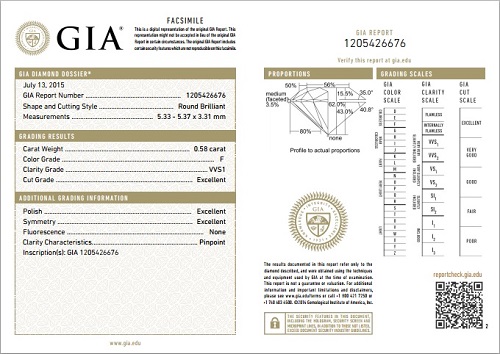
There is only a limited amount of information you can derive from a certificate.
Here are some emails I frequently receive from these readers…
“Would you be able to take a look at a GIA report (1179571313) and tell me if it is a good diamond?”
“I’m trying to determine which is the best diamond to purchase and would like to seek your advice on these options.
http://www.bluenile.com/diamond-details/LD06166898
http://www.bluenile.com/diamond-details/LD06012401
http://www.bluenile.com/diamond-details/LD06171528
Attached are their GIA grading reports. (1209244291, 6205182287, 2175250240) Can you tell me which is the most beautiful stone and why?”
The truth is, I have no answers to these questions and I’m just as clueless as you are. In order for me to give you any meaningful analysis, you need to provide me with more details such as magnified images, Sarin, ASET/Idealscope images, hearts and arrows images (for round diamonds) and videos.
This is because a grading report doesn’t reveal tangible details about the diamond’s appearance. And this is exactly why it’s a huge mistake to base a purchase on it alone.
If you didn’t know yet, online e-commerce is no longer what they used to be. Today, if you are still buying diamonds based on a grading report alone, you better be reconsidering who you are doing business with.
For the record, trying to sell diamonds online with only a grading report is the prehistoric way of doing things. Sadly, outdated business models like this are still prevalent on the Internet. And they are exactly the kind of vendors I always warn readers to stay away from.
The Proportions of a Round Brilliant Cut Diamond MATTERS!
If you want a round diamond that’s bright and sparkly, refer to my chart of ideal proportions when you go shopping. For diamonds with proportions that fall out of those ranges, I would instantly reject them without even taking a second look.
Now, I want to be absolutely clear about this.
Good diamond proportions are only a prerequisite to having great optical performance. However, just because a diamond has great proportions, it DOES NOT GUARANTEE the best light performance.
Here’s an analogy to help you understand things better.
The basic requirements of becoming a military pilot requires an applicant to have uncorrected distant vision which doesn’t exceed 20/200. So, if someone has a perfect vision of 20/20, does that necessarily make him/her the best fighter pilot out there?
Well, it doesn’t. There are many more factors that will come into play here.
In the same way, the light performance of a diamond isn’t guaranteed just because it has good proportions! Let me illustrate this with some real life examples…

Both round brilliant cut diamonds exhibit similar proportions and are GIA triple excellents (on the left; GIA#: 6173235371 and on the right; GIA#: 1179615115. Based on the numbers in a grading report, both diamonds look good on paper. Yet, that’s not the case in real life.
You need to understand that the angles displayed in a proportions diagram are based on averaged measured values. The problem with averaged values is that slight deviations in facet angles go unnoticed but these subtle differences may affect the diamond’s light performance in a huge manner.
ASET/Idealscope images reveal a diamond’s performance.
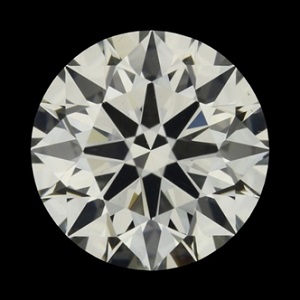
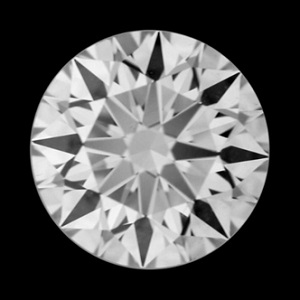
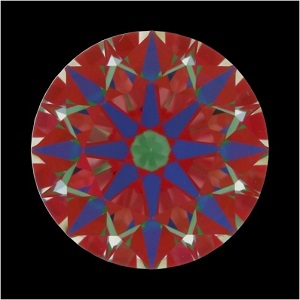
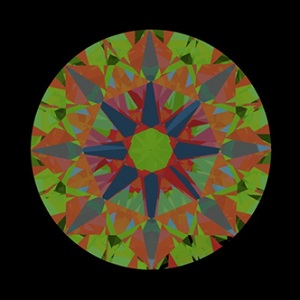
The diamond on the left has ideal optics while the one on the right has a performance that leaves more to be desired. You can compare them against the ASET reference charts here and see the vast differences between these 2 diamonds for yourself.
This is why buying diamonds blindly with nothing more than a grading report is such a bad idea. And this brings me to the next point where people blindly use a tool called the HCA for all the wrong reasons.
The HCA Tool – Why It Is More Of a Foe When You Fail to Use It Correctly
There are many consumers who get too hung up by what the HCA score says. You see, the HCA tool was created many years ago when Internet/video technology wasn’t established. At that time, shoppers were expected to buy diamonds based solely on the information of a grading report (think BlueNile).
As I mentioned earlier in this article, much has changed. Vendors like White Flash and Brian Gavin Diamonds offer tangible data of their diamond listings which ensures you never buy blind.
Now, I want you check out this diamond with really great looking proportions on paper. You’ll see why the HCA score is an epic failure if you try to use it as a selection tool instead of relying on tangible performance data.
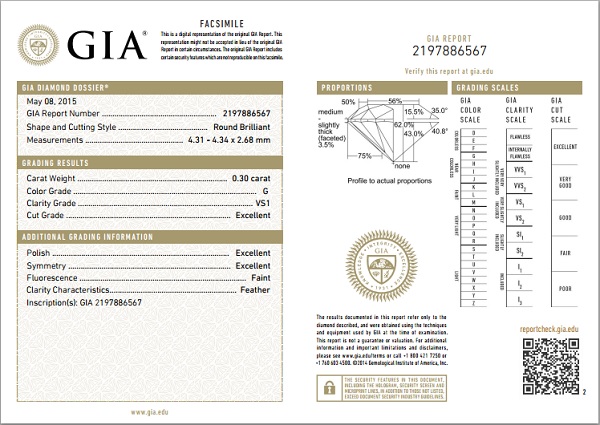
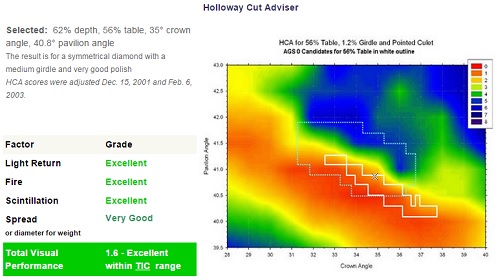
The HCA tool returns an amazing score of 1.6 for Total Visual Performance and describes the stone as “Excellent within TIC range”. So, how does the diamond look like in real life?
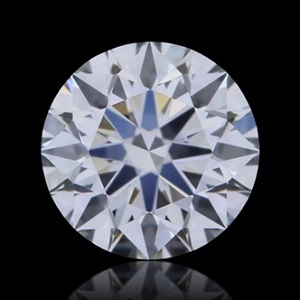
Truth be told, it’s not a bad diamond per se. There are many other diamonds that fare much worse. It’s just a mediocre diamond that is cut like the majority of other GIA triple excellent diamonds in the market.
Here’s an ASET image of the diamond that critically reveals the light performance of the stone.
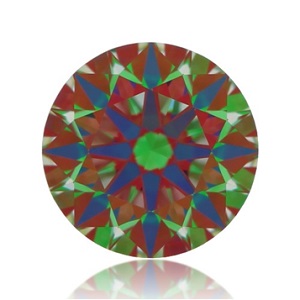
So much for scoring a “great” 1.6 on the HCA, this diamond simply doesn’t jive in terms of optical performance. Notice how the diamond displays light leakage under the table? I also want to bring your attention to how the girdle of the diamond is painted for weight retention and lesser brilliance. This is indicated by the green splotches near the edges of the stone.
If you simply use the HCA tool to judge a diamond’s cut quality, you will most likely end up with a sub-par stone. So, here’s my question to you: do you want a mediocre diamond or one that is cut for exceptional light performance?
What About Fancy Shaped Diamonds?
If the idea of buying round brilliant cut diamonds based on numbers isn’t bad enough, trying to buy fancy shaped diamonds based on numbers is a notion that’s even more ludicrous.
Compared to round diamonds, there’s even less analytical information available in the grading reports for fancies! Check out the comparison below…
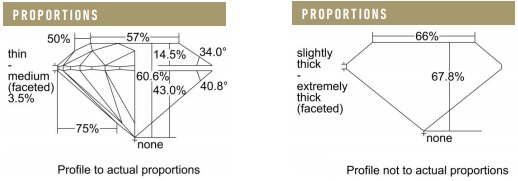
On the left is a typical proportions diagram for a round diamond. Compare it to what you get in a typical GIA report for any fancy shaped diamond on the right.
More importantly, the table % and depth % tells you nothing about the diamond’s appearance and its optical performance. Basically, you are taking a wild shot in the dark if you shop purely by numbers.
Let me illustrate this by using 3 randomly selected cushion cut diamonds which appear to be similar based solely on their GIA grading reports. Note: these diamonds also possess an identical facet structure and similar table/depth proportions.
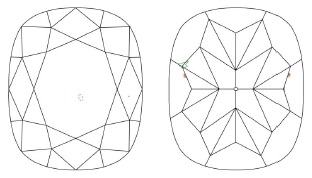
You can access full details for each diamond by clicking on their corresponding images…
Despite having almost identical proportions on paper, each of these 3 diamonds look distinctly different from the other. Also, they each display different levels of light performance and brilliance.
This is why you need detailed videos/photographs and ASET images in order to make educated decisions. For those of you who are in the market for a fancy shaped diamond, here’s a complete step by step guide to guide you through the selection process.
Buying Diamonds Without Seeing Details Is a Recipe For Disaster
Here’s another scenario which frequently occurs when readers contact me for help. In many cases, these readers want a validation or a second opinion on a diamond they are about to buy blindly from either local dealers or online sources.
“Are these diamonds good choices and whether their inclusions are visible?”, “Did I make the right decision with this SI2 diamond?”, “I’m worried about the clarity of the diamond. Can you tell me which diamond would be the best option based on the grading reports I sent?” or questions like “Could you provide some feedback on the cloud inclusion of this diamond?”.
Again, the fact of the matter is, I don’t know and no one else does as well. There’s no way anybody can tell you which diamond is the best choice because of the lack of information.
It’s like selecting the winner of a beauty pageant contest based on vital statistics without any knowledge of how the contestants look like in real life.
Take a look at the following 1 carat emerald cut diamond graded by GIA as a VS2. By looking at the clarity plot alone, I know most people would automatically assume the diamond to be eye clean.
After all, isn’t a VS2 clarity rating is a pretty “safe” choice for eye-cleanliness? Well, that’s a misconception and not all VS2 diamonds are eyeclean. It depends on a cases by cases basis and the best way to be sure is through the use of magnified videos/images or eyeballing the stone in person.
Here’s another example of why the information listed in a grading report alone isn’t sufficient for you to a make conclusive analysis of eye-cleanliness.
As you can see, this AGS graded SI1 round diamond displays a relatively clean clarity plot that doesn’t seem to indicate anything serious. Yet in reality, the diamond has a conspicuous color crystal inclusion under the table facet.
A Point to Prove – Is This Diamond Eye Clean?
Here’s a clarity characteristic plot of a 1.05 carat diamond with K color and SI2 clarity grade (GIA 2176531985). Based on the clarity diagram, can you tell whether this is a good diamond and if it is eye clean? Would you ever consider buying this diamond after seeing its plot?
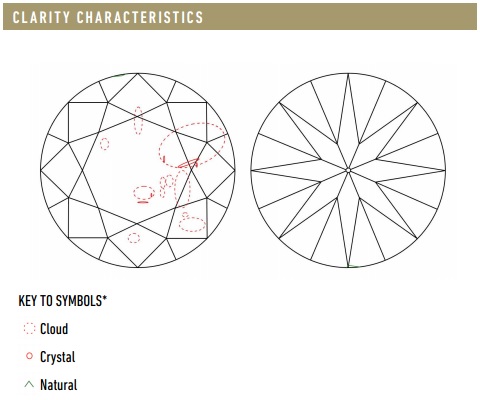
Once again, I need to emphasize that it is impossible to make deductions with any further information. It’s like handing someone a map of a place they never been to and asking them to describe how the place looks like.
So, let’s reveal how this nasty looking clarity plot actually appears in real life with a magnified image. If you want to, you can also interact with a HD video of the stone here.
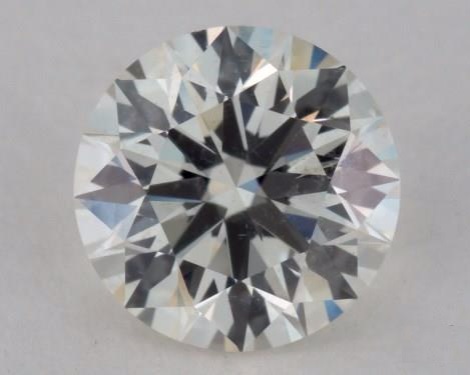
Surprised? This diamond is actually eye clean!
Still Insisting On Buying Blind?
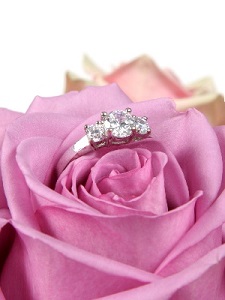 Having read through this entire article, I hope you learnt something.
Having read through this entire article, I hope you learnt something.
If you aren’t a risk taker and you want a peace of mind when you shop, never buy blind without seeing details.
Whether you are buying in a local jewelry store or an online establishment, you should seriously reconsider your choice of vendor if they can’t provide you with tangible data like magnified photographs, videos, ASET/Idealscope images and etc…
Now, I’m not afraid to be upfront about dishing out constructive advice. If you are en route to making bad purchase decisions, would you prefer to have straight up advice to steer you back in the right direction? Or would you rather have someone who simply affirms your actions and tell you the “nice” stuff you want to hear?
I know the information presented above may come across to some people as hard-hitting and there will be people who would remain stubborn to good advice. If this article doesn’t knock some sense into you and you are still adamant about buying diamonds based on numbers alone, that’s fine.
As long as you know about the risks involved and you are prepared to bear the consequences of making expensive mistakes, who am I to tell you how to spend your money? After all, you may just get really lucky and end up with a beautiful diamond.
For people on the other side of the camp who are looking for a reliable and proven method of selecting the best diamonds within any given budget, click here for a comprehensive step-by-step guide.
Related Articles
Leave A Comment

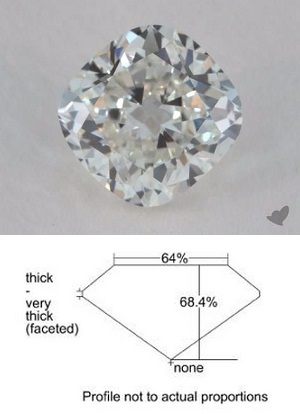
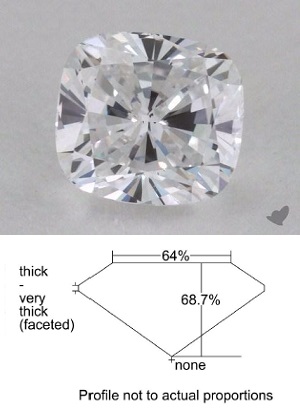
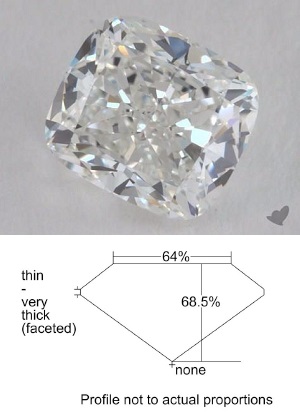
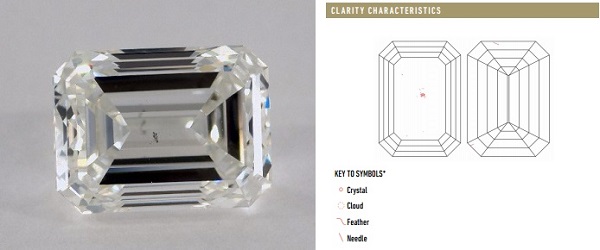
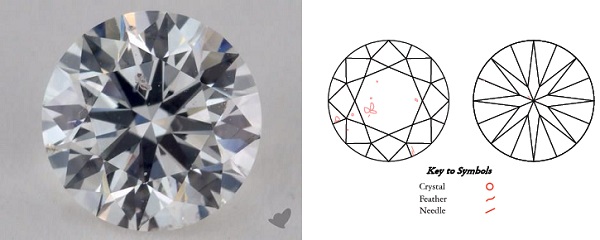
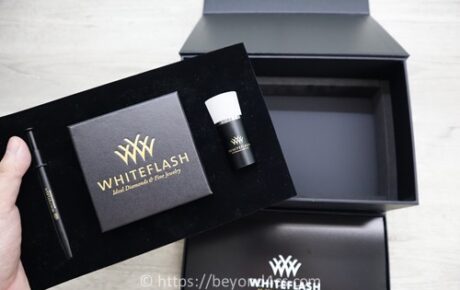

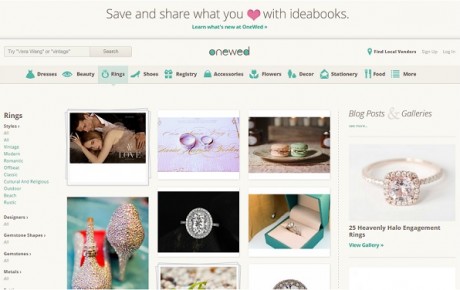
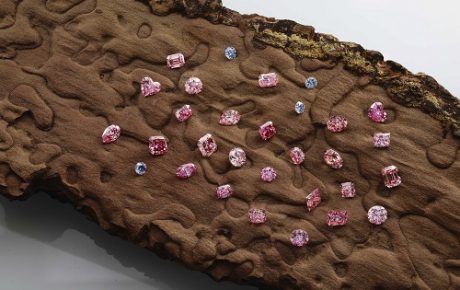









21 Comments
Hi Paul,
I would like to follow your guidance but I need to find a shop which will ship ring from European Union (due to high taxes if it is shipped from USA). Could you recommend one?
Thank you in advance!
Andrzej
Blue Nile ships from the EU. You may want to check them out here: https://www.bluenile.com
Hi Paul,
I am looking at two 1ct diamonds (both SI2) but unsure on which to go with. The HRD certified colour F has very few inclusions, and the GIA certified colour G has a few more inclusions.
Can you please provide comment on HRD vs GIA certifications?
Thanks very much.
Michael
HRD is a popular grading report found in EU but I don’t place them on par as GIA. And if you had read and understood this article, you wouldn’t be asking me this question without showing me tangible cut data.
Hi Paul,
What are your recommendations on inclusions on the table facet? Would you completely avoid it or under some circumstances would be okay?
I am really interested in the ring below at ED SKU R272-358631574, could you give me your opinion?
The inclusions are not the problem here. Cut quality is and this stone isn’t well cut enough. These would be 2 diamonds I would recommend instead:
https://www.whiteflash.com/loose-diamonds/round-cut-loose-diamond-3782387.htm
https://www.whiteflash.com/loose-diamonds/round-cut-loose-diamond-3811455.htm
They are much much better options than the mediocre stone you selected.
Hey Paul, excellent website! The following diamond is considered eye-clean, but worries about the cloud inclusions that surround it. Do you believe this will impact light performance and not show as crisp? Thanks.
https://www.whiteflash.com/loose-diamonds/round-cut-loose-diamond-3664931.htm
I’ve reviewed the information and data on that listing. The cloud inclusions will not affect the appearance or performance of the diamond. So, no worries there.
Paul,
your website is a great source of information and I’ve spent endless hours already reading it…. but looking for a bit of advice.
I’m looking to buy a diamond that falls outside your ideal proportions but its been offered to me at the reasonable price.
its 1.01carat, H colour, SI1 clarity and Good cut but I’m mostly concerned about the proportions as it has the following dimensions
6.34*6.43*3.84
table 65%
depth 60.1%
crown angle 29.5
pav angle 41
Just worried with such a large table it will not reflect light well and will not have the sparkle.
What your view on such stone?
This is an absolutely horrible diamond. Cutwise, it is a train wreck. If you had actually read the website and learnt anything, you would have known and figured this out. Clearly, you didn’t. This stone is just a bad use of money if you purchase it. Run!
Hi Paul, would you recommend Blue Nile as a good source of online vendor based on their GIA report and 360 degree HD 20x magnification videos?
In other words should i even bother shopping with them if my search filter is only for GIA and 360 degree video?
BlueNile is OK if you stick with listings with videos or their signature lines. They have improved significantly over the past year by being more transparent with their listings.
What about Brilliant Earth? Very few of their lab-created diamonds have actual photos.
That’s the problem with buying from Brilliant Earth because of the lack of information on the listings. You could either:
1) Request for images on diamonds you are interested in. It’s very much of a hassle and they should have provided them on the listings to begin with.
2) Only look at diamonds with videos/images. There’s a function in their search bar to do this filter.
Hi Paul, first off I need to thank you for the wealth of information I have stumbled upon within your site. As a diamond newbie, I have absorbed so much from just one place. It’s amazing.
I entirely understand the preference of reputable online retailers over brick & mortar stores due to the ability to preview the actual stone up close with reports. But as a buyer from Australia, the exchange rate makes ordering from places like JamesAllen slightly more expensive for “similar quality” diamonds.
I guess my question is on whether getting IdealScope and ASET reports would justify that extra cost?
Justin,
The main reason I tell people for going online is not because of cost (that’s just a by product of shopping online). It is because of product selection and cut quality. Diamonds are traded in USD. Let me tell you that your local retailers regardless of online or brick and mortar, buy their diamonds in USD and undergo FX charges the same way you do when you shop. When you actually see price differences going the other way for online prices, you are likely doing your comparisons wrongly.
Read this article: https://beyond4cs.com/diamond-prices/
HI Paul,
I’ve read a lot from your site, but unfortunately I did buy blind. One for Adiamor and one from Blue Nile. I have them both in person and trying to see if they are both good or if one is better than the other. Can I get your email to send you what I have and maybe you can help me? Thanks
You can reach me directly here: https://beyond4cs.com/about/contact-us/
Hi Paul, I could really use your help on this difficult decision I am torn to make. I fell in love with two diamonds: a 2.124 and a 2.008 h&a cushions. Here’s a little info:
The 2.124 is quite larger than the 2.008. I believe the 2.124 meets the 4 c’s ideal cut proportions for all criteria. But in the ASET images there is a noticeable inclusion in the center of the table. I am worried if/how much noticeable this would be on a 2.124 diamond.
The 2.008 is also beautiful. In the images it appears just as brillant but several areas of the proportions fall just out of the recommended ranges for ideal cut. The 2.008 is quite a bit smaller but it does not appear to have noticeable inclusions.
Which one would you consider more beautiful, brilliant and of higher value?
Here are the details:
https://www.briangavindiamonds.com/diamonds/diamond-details/2.124-f-vs2-cushion-diamond-ags-104097793025
https://www.briangavindiamonds.com/diamonds/diamond-details/2.008-e-vs2-cushion-diamond-ags-104094952002
The first stoneis the better buy. The diamond is eyeclean by my standards and extremely well cut. If I were to be totally anal about cut quality, this is the better pick over the E diamond.
The other diamond is a good choice IF you think the inclusions affect you psychologically. But you are paying more for features that your eyes probably can’t observe.
https://beyond4cs.com/clarity/resize-technique/ => Read this and then click the links above to test for eyecleanliness yourself.
From experience, I would say both stones will look identical side by side. The practical mindset in me is saying “go for the first diamond”.
I did a ton of research and followed your guidance and scored bigtime! I purchased from an online retailer and felt very comfortable doing so armed with all the facts. I shopped beyond the 4c’s, pardon the pun. For my emerald cut diamond I looked at the dimension ratio, crown angle, pavilion angle, and the depth of both. My retailer had the actual diamond picture 3-D, and the Aset picture available. I reviewed the GIA report for typical grading information.
I did however choose a setting from a local retailer and am very pleased with my final wedding set.
I had to go to three retailers, because the first two were EXTREMELY put off by the fact that I was savvy enough to purchase my own diamond. Their actions and responses said it all. They weren’t nasty or too rude. But, basically, it was like how dare you not allow us to take advantage of you. Too funny!!!!
Thank you for looking at my last two selections and giving me even more insight. It helped me to make a final decision and I am very happy.
If I can do this anyone can.